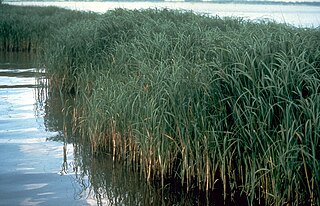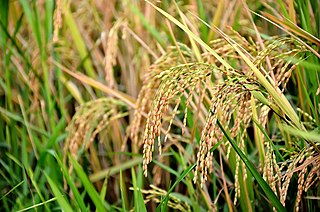Related Research Articles

Rice is a cereal grain, and in its domesticated form is the staple food for over half of the world's human population, particularly in Asia and Africa, due to the vast amount of soil that is able to grow rice. Rice is the seed of the grass species Oryza sativa or, much less commonly, O. glaberrima. Asian rice was domesticated in China some 13,500 to 8,200 years ago, while African rice was domesticated in Africa some 3,000 years ago. Rice has become commonplace in many cultures worldwide; in 2021, 787 million tons were produced, placing it fourth after sugarcane, maize, and wheat. Only some 8% of rice is traded internationally. China, India, and Indonesia are the largest consumers of rice. A substantial amount of the rice produced in developing nations is lost after harvest through factors such as poor transport and storage. Rice yields can be reduced by pests including insects, rodents, and birds, as well as by weeds, and by diseases such as rice blast. Traditional polycultures such as rice-duck farming, and modern integrated pest management seek to control damage from pests in a sustainable way.
Halotolerance is the adaptation of living organisms to conditions of high salinity. Halotolerant species tend to live in areas such as hypersaline lakes, coastal dunes, saline deserts, salt marshes, and inland salt seas and springs. Halophiles are organisms that live in highly saline environments, and require the salinity to survive, while halotolerant organisms can grow under saline conditions, but do not require elevated concentrations of salt for growth. Halophytes are salt-tolerant higher plants. Halotolerant microorganisms are of considerable biotechnological interest.

A halophyte is a salt-tolerant plant that grows in soil or waters of high salinity, coming into contact with saline water through its roots or by salt spray, such as in saline semi-deserts, mangrove swamps, marshes and sloughs, and seashores. The word derives from Ancient Greek ἅλας (halas) 'salt' and φυτόν (phyton) 'plant'. Halophytes have different anatomy, physiology and biochemistry than glycophytes. An example of a halophyte is the salt marsh grass Spartina alterniflora. Relatively few plant species are halophytes—perhaps only 2% of all plant species. Information about many of the earth's halophytes can be found in the halophyte database.

Oryza is a genus of plants in the grass family. It includes the major food crop rice. Members of the genus grow as tall, wetland grasses, growing to 1–2 metres (3–7 ft) tall; the genus includes both annual and perennial species.

Oryza sativa is much the more common of the two rice species cultivated as a cereal, the other species being O. glaberrima, African rice. It was first domesticated in the Yangtze River basin in China 13,500 to 8,200 years ago.

Ancistrocladus is a genus of woody lianas in the monotypic family Ancistrocladaceae. The branches climb by twining other stems or by scrambling with hooked tips. They are found in the tropics of the Old World.

Distichlis palmeri is an obligate emergent perennial rhizomatous dioecious halophytic C4 grass in the Poaceae (Gramineae) family. D. palmeri is a saltwater marsh grass endemic to the tidal marshes of the northern part of the Gulf of California and Islands section of the Sonoran Desert. D.palmeri is not drought tolerant. It does withstand surface drying between supra tidal events because roots extend downward to more than 1 meter where coastal substrata is still moist.

Pandanus amaryllifolius is a tropical plant in the Pandanus (screwpine) genus, which is commonly known as pandan. It has fragrant leaves which are used widely for flavouring in the cuisines of Southeast Asia. It is also featured in some South Asian cuisines and in Hainanese cuisine from China.

Oryza barthii, also called Barth's rice, wild rice, or African wild rice, is a grass in the rice genus Oryza. It is an annual, erect to semierect grass. It has leaves with a short ligule, and panicles that are compact to open, rarely having secondary branching. The inflorescence structure are large spikelets, 7.7–12.3 millimetres long and 2.3–3.5 millimetres wide, with strong awns, usually red. The inflorescences have anthers 1.5–3 millimetres long.

Oryza rufipogon, known as brownbeard rice, wild rice, and red rice, is a member of the genus Oryza.

A crop wild relative (CWR) is a wild plant closely related to a domesticated plant. It may be a wild ancestor of the domesticated (cultivated) plant or another closely related taxon.
Oryza nivara is a wild progenitor of the cultivated rice Oryza sativa. It is found growing in swampy areas, at edge of pond and tanks, beside streams, in ditches, in or around rice fields. Grows in shallow water up to 0.3 metres, in seasonally dry and open habitats.

Perennial rice are varieties of long-lived rice that are capable of regrowing season after season without reseeding; they are being developed by plant geneticists at several institutions. Although these varieties are genetically distinct and will be adapted for different climates and cropping systems, their lifespan is so different from other kinds of rice that they are collectively called perennial rice. Perennial rice—like many other perennial plants—can spread by horizontal stems below or just above the surface of the soil but they also reproduce sexually by producing flowers, pollen and seeds. As with any other grain crop, it is the seeds that are harvested and eaten by humans.
Wild rice are four species of grasses forming the genus Zizania, and the grain that can be harvested from them.
Oryza punctata is an annual grass in the rice genus Oryza, also known as red rice, related to cultivated rice O. sativa. O. punctata forms clumps or tussocks from 50–120 cm tall. It is a native to tropical Africa and Madagascar but is also found in Thailand and other parts of Indochina. O. punctata is a weed species in commercial rice growing operations although it appears to be rare in its native range. O. punctata has an IUCN status of least concern. It is not generally eaten or used as fodder by farmers but there is some evidence that it has been used as such during periods of famine. Due to the importance of the crop varieties of rice globally, the evolution of the Oryza genus as a whole has been studied extensively. A lot of information about O. punctata has been elucidated as a secondary benefit to this commercial research. O. punctata evolved some 5 million years ago in the second of two rapid radiation events that occurred in the Oryza L. genus.

Aeluropus lagopoides, sometimes called mangrove grass or rabbit-foot aeluropus, is a species of Eurasian and African plant in the grass family, found primarily in salty soils and waste places.
Altericroceibacterium indicum is a gram-negative, rod-shaped and non-spore-forming bacterium from the genus Altericroceibacterium which has been isolated from the rhizosphere from the rice plant Porteresia coarctata in Pichavaram in India.
Mangrovibacter is a genus in the order Enterobacterales. Members of the genus are Gram-stain-negative, facultatively anaerobic, nitrogen-fixing, and rod shaped. The name Mangrovibacter derives from:
Neo-Latin noun mangrovum, mangrove; Neo-Latin masculine gender noun, a rod; bacter, nominally meaning "a rod", but in effect meaning a bacterium, rod; Neo-Latin masculine gender noun Mangrovibacter, mangrove rod.
Oryza latifolia, the broadleaf rice, is a widespread species of grass. It is native to wetter areas of Latin America and the Caribbean, and has been introduced to India, Bangladesh, Myanmar, Laos, and Vietnam. A facultative aquatic perennial, if flooded it can adapt by growing considerably taller.
In biology, parallel speciation is a type of speciation where there is repeated evolution of reproductively isolating traits via the same mechanisms occurring between separate yet closely related species inhabiting different environments. This leads to a circumstance where independently evolved lineages have developed reproductive isolation from their ancestral lineage, but not from other independent lineages that inhabit similar environments. In order for parallel speciation to be confirmed, there is a set of three requirements that has been established that must be met: there must be phylogenetic independence between the separate populations inhabiting similar environments to ensure that the traits responsible for reproductive isolation evolved separately, there must be reproductive isolation not only between the ancestral population and the descendent population, but also between descendent populations that inhabit dissimilar environments, and descendent populations that inhabit similar environments must not be reproductively isolated from one another. To determine if natural selection specifically is the cause of parallel speciation, a fourth requirement has been established that includes identifying and testing an adaptive mechanism, which eliminates the possibility of a genetic factor such as polyploidy being the responsible agent.
References
- ↑ "entry for Porteresia". World Checklist of Selected Plant Families. Retrieved 15 February 2014.
- ↑ "The Plant List" . Retrieved 1 February 2015.
- 1 2 Kew World Checklist of Selected Plant Families, entry for Oryza
- ↑ "Tropicos.org" . Retrieved 1 February 2015.
- ↑ Kabir, SM Humayun (2012). "Rice". In Islam, Sirajul; Jamal, Ahmed A. (eds.). Banglapedia: National Encyclopedia of Bangladesh (Second ed.). Asiatic Society of Bangladesh.
- ↑ Sengupta, S.; Majumder, A. L. (2010). "Porteresia coarctata (Roxb.) Tateoka, a wild rice: A potential model for studying salt-stress biology in rice". Plant, Cell & Environment. 33 (4): 526–542. doi: 10.1111/j.1365-3040.2009.02054.x . PMID 19843254.
- ↑ Flowers, T. J.; Flowers, S. A.; Hajibagheri, M. A.; Yeo, A. R. (April 1990). "Salt Tolerance in the Halophytic Wild Rice, Porteresia coarctata Tateoka". The New Phytologist. 114 (4): 675–684. doi: 10.1111/j.1469-8137.1990.tb00439.x . JSTOR 2556839.
- ↑ Rangan, L.; Sankararamasubramanian, H. M.; Radha, R.; Swaminathan, M. S. (2002). "Genetic relationship of Porteresia coarctata Tateoka using molecular markers". Plant Biosystems. 136 (3): 339–348. Bibcode:2002PBios.136..339R. doi:10.1080/11263500212331351239. S2CID 84612331.
- ↑ Rajakani, Raja; Sellamuthu, Gothandapani; Saravanakumar, V.; Kannappan, S.; Shabala, Lana; Meinke, Holger; Chen, Zhonghua; Zhou, Meixue; Parida, Ajay; Shabala, Sergey & Venkataraman, Gayatri (2019). "Microhair on the adaxial leaf surface of salt secreting halophytic Oryza coarctata Roxb. show distinct morphotypes: Isolation for molecular and functional analysis". Plant Science. 285: 248–257. doi:10.1016/j.plantsci.2019.05.004. PMID 31203890. S2CID 164424933.
- ↑ Jagtap, T.G., Bhosale, S. and Charulata, S., 2006. Characterization of Porteresia coarctata beds along the Goa coast, India. Aquatic Botany, 84(1), pp.37-44.